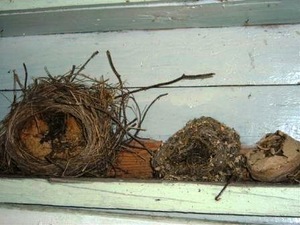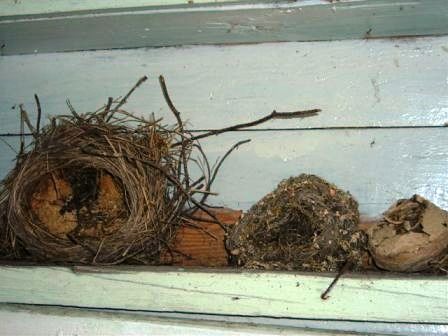IN MEMORIAL OF A.VAITKŪNAS. NESTS 0
Aušra Barzdukaitė-Vaitkūnienė
www.kamane.lt , 2007 10 01
A.Vaitkūnas. “Broken Nets of Hornets”. 1988, canvas, oil. 70x90 cm
Arūnas was not interested in things without tradition. Neither things nor places. Still, he followed all novelties. Travelling round Lithuania, its sacral places, he constantly drew more interesting objects, took notes of insights or wrote down old epitaphs of tombstones. The accumulated material, his interest in history and traditions has formed his intellectuality of his paintings.
He melted emotional expression with intellect in painting. This is why his paintings are multi-layered. It is not only expression of surface; according to one art critic, one needs to pass the surface as radio noise, and the deep construction of the world and insights of meanings will be found underneath. One needs to know the context of European art to understand the paintings of Arūnas.
The feeling of longing and loneliness are the satellites of Arūnas’ life. He never had real close friends. The ones who knew him better could see that, being the soul of the company, he felt lonely. Perhaps this is the reason why philosophers existentialists were close to him.
When our friendship started, he used to complain: “I am constantly alone.”
And then he asserted after a while: “You know, one should not attach to anyone. You get used to it then...”
Such a heartbreaking contradiction was the result of the painful experience of life, most probably.
The motifs with nests testify about his craving for warmth and spiritual openness, though.
However, these are nests of hornets.
What does a nest symbolise? Warm, cosy and safe life? What is hidden in the hornets’ nest? During the period of loneliness and painful experience, Arūnas painted the work “Broken Nests of Hornets” in Dovainonys in 1988.
The painting of dark colours, rough and heavy facture, stretching forms are dramatic and painful. The painting is no exception from other canvases of Arūnas by its inside mood. The livery mass of paint grows plastic forms organically. Similar to a ploughshare, the brush ploughs the soil of paint. The beds of the painting surface are slippery in some places, but the fundamental strokes form the original movement, which calms down only in the top part of the painting. Horizontal strokes, grey, green tones transform into reflections of evening red and finish the drama of broken nests.
Arūnas gathered a collection of nests much later. This symbol remained close to him as a motif. When the three of us used to travel along forests and fields and he found some nest, he brought it back to his collection. However, he did not paint them any more. The found nests were merry and cosy. Arūnas viewed them rejoicing and said: “The fullness of life.”


